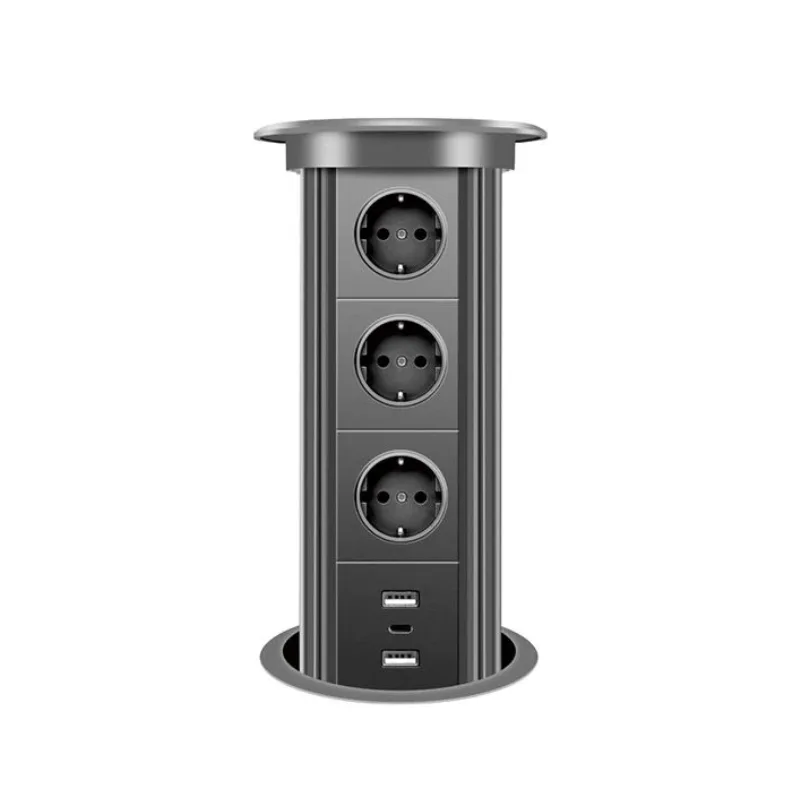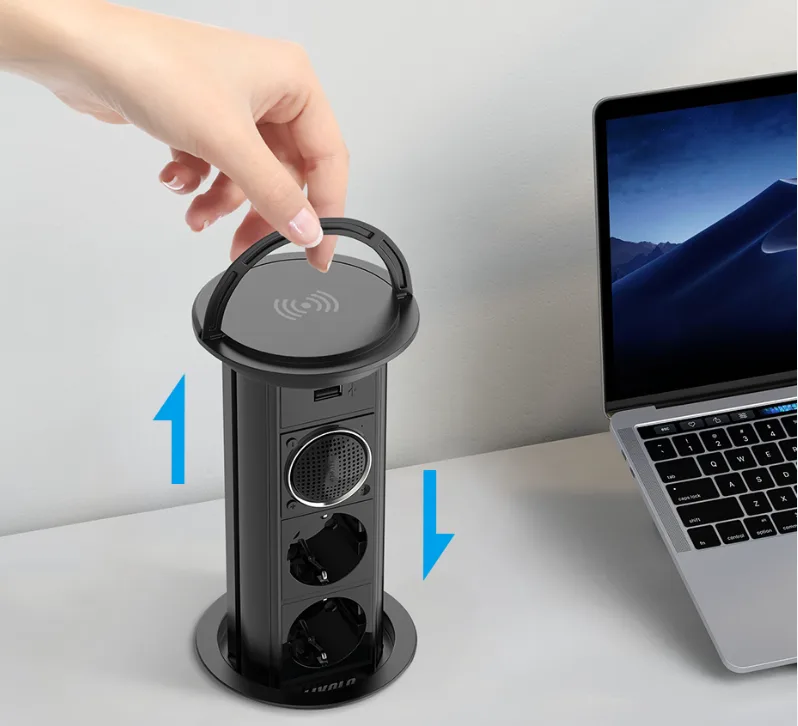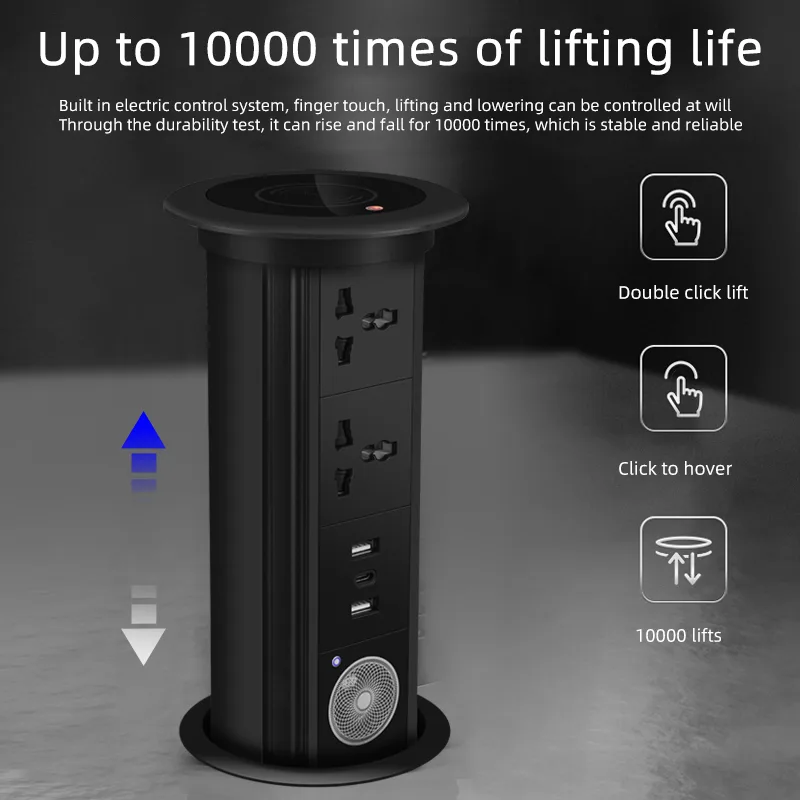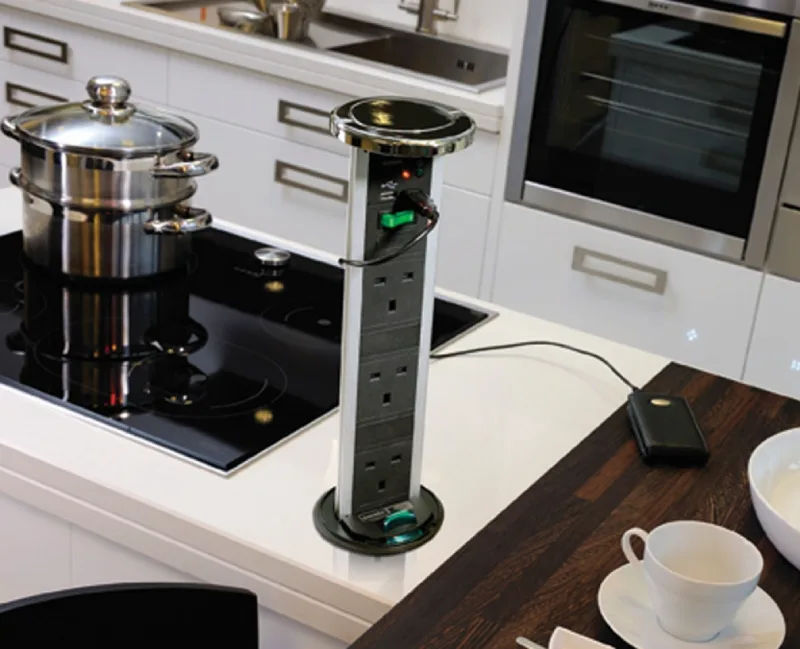Tired of cluttered countertops or constantly searching for accessible power outlets? Pop up sockets offer a sleek, modern solution to power needs in kitchens, offices, and beyond. These innovative retractable outlets provide convenient access to electricity while maintaining clean, uncluttered surfaces when not in use.
Whether you’re renovating your kitchen island, upgrading your office desk, or simply seeking a smarter way to access electricity, pop up sockets (also known as retractable outlets) provide a sophisticated and practical alternative to traditional wall-mounted sockets. Say goodbye to unsightly cables and hello to convenient, hidden power.
What is a Pop Up Socket and Why Do You Need One?
At its core, a pop up socket is a type of electrical outlet that works using a retractable mechanism enabling it to be hidden flush within a bench-top when not in use, but then easily brought up when required. These innovative power solutions combine functionality with aesthetics, offering seamless integration into various surfaces while providing instant access to electrical outlets when needed.
Pop up sockets serve as the modern alternative to traditional wall outlets, particularly valuable in areas where conventional electrical access is limited or aesthetically undesirable. Pop up counter outlets are designed to make life in the kitchen more convenient and fitting for the twenty-first century.
Key Benefits of Pop Up Sockets
Space-Saving Design: This is perhaps the most significant advantage. By retracting into the surface, these sockets help you “declutter with a pop up socket,” freeing up valuable workspace, especially in compact areas.
Enhanced Aesthetics: With their ability to disappear when not in use, they contribute to a sleek, modern, and minimalist aesthetic. No more unsightly outlets interrupting your beautiful backsplash or a polished desk surface.
Enhanced Safety: Eliminate dangerous drooping cords hanging over the edge of the island and keep your work surface organized with beautiful tamper-resistant waterproof sockets. This design significantly reduces trip hazards and accidental damage to electrical cords. Keeps outlets less accessible to young children when retracted.
Convenient Access: They provide “easy access power outlets” exactly where you need them – be it on a kitchen island for your appliances or on a conference table for laptops and chargers.
Common Applications
Kitchens: Ideal for islands, peninsulas, and main countertops where space optimization and aesthetics are priorities.
Offices: Perfect for individual desks, shared workstations, and conference tables requiring clean, professional appearances.
Workshops & Garages: Provides convenient power for tools without permanent fixtures taking up space.
Commercial Spaces: Hotels, libraries, and airport lounges often use them for public convenience.
Types of Pop Up Sockets: Finding Your Perfect Match
Understanding the different types of pop up socket mechanisms will help you choose the one that best suits your needs and budget.
Manual Lift Pop Up Sockets
Models that require manual lift operate in two ways: Use your fingers to push down on a flap, and then grab on the center stem to raise it. Push with your fingers on the top lid to make it ‘pop-up’ about 2cm. Then grab this top lid to lift the unit up the rest of the way.
Manual lift systems offer reliable, cost-effective operation with minimal maintenance requirements. These entry-level models typically range from $50-$80 and provide excellent durability for residential applications. They are straightforward and reliable due to fewer moving parts.
Gas Strut Assisted Pop Up Sockets
Models that operate with a gas strut automatically raise from the press of the top lid, but need to be re-pressurised back down into their ‘closed’ position. They function in a similar way to an office chair, where a gas strut is pressurised in the downward position, and is released when pushed.
Gas strut mechanisms provide automatic lifting with manual closing, offering a balance between convenience and cost-effectiveness. These offer a smoother, more controlled lift with a gentle push being all that’s needed.
Motorized Pop Up Sockets
A motorized lifting mechanism is the most convenient and premium method of raising a pop up power socket. It operates by the touch of the lid – a resistive touch button under a glass lid will sense a finger press and raise/lower the unit through the use of an internal motor.
For a touch of luxury and convenience, these “automated pop up outlets” rise and retract with the press of a button or a touch-sensitive sensor. Premium motorized units typically include wireless charging capabilities and LED indicators, with prices ranging from $200-$400 depending on features and build quality.
Specialized Mounting Styles
Vertical Pop Up Towers: The most common type featuring cylindrical or rectangular towers that extend vertically from the surface.
Horizontal/Flush Pop Up Sockets: Less common designs that sit flush with the surface and may pop up at an angle, sometimes found in flooring applications.
Recessed/In-Desk Sockets: Units recessed into surfaces with lids that open to reveal power and data ports, serving similar concealment purposes.
Essential Features and Specifications
Power and Connectivity Options
Standard Power Outlets: Basic models provide only standard electrical sockets (Type G for UK, Type B for US).
Pop Up Sockets with USB Ports: Increasingly popular models include USB-A and/or USB-C ports for charging phones, tablets, and other devices directly, often featuring fast charging capabilities. This is essential for modern “desk pop up sockets.”
Pop Up Sockets with Wireless Charging: High-end models integrate Qi-compatible wireless charging pads on the top surface, allowing device charging simply by placement when the socket is retracted.
Pop Up Sockets with Data Ports: Essential for office environments, these include Ethernet (RJ45), HDMI, or audio ports, providing complete connectivity hubs.
Critical Sizing Measurements
There are three key measurements for sizing a pop-up socket: Hole diameter – this indicates the diameter (or bulkiness) of the unit. Sizes range from 60mm up to 120mm. It’s also worth noting – the skinny units are usually taller and deeper, and the larger diameter units are shorter and shallower.
Planning Considerations:
- Cutout Size: Diameter or dimensions of the required hole in your surface
- Height When Extended: Ensures no obstruction when fully popped up
- Depth Below Surface: Critical clearance requirement underneath countertops
Material and Build Quality
Common materials include stainless steel, aluminum, and durable plastics. Finishes range from brushed metal to black, white, or custom colors to match your decor. Its important to buy appliances that last the lifetime of your space. Kitchens should last 30+ years, so its important to choose a pop-up device that is durable to sustain everyday use over this time.
Safety and Code Compliance
Waterproof Protection and IP Ratings
The lid on the V3CW model is designed to keep liquid away from the electrics when closed. It has a outer flange that tightly grips when closed – creating a seal. This is ideal in the case of an accidental spill of liquid on your kitchen worktop.
IP ratings consist of two digits (e.g., IP44). The first digit indicates protection against solids (dust), and the second against liquids (water). For kitchens, look for models offering splash resistance when closed. In the closed position the stainless steel top features an IP66 water protection level making it perfect for outdoor applications.
Electrical Code Requirements
Shop for recessed pop up electrical outlets that are spill-proof safe for kitchen countertops, and UL 498 approved to pass the latest 2023 NEC code 406.5E. Always verify that units meet local electrical codes and safety standards.
Indeed, provided the assembly is UL listed for the purpose, there are no Code issues involved. The applicable passages are 210.52(C)(5): Receptacle outlets shall be located on or above, but not more than 500 mm (20 in.) above, the countertop.
Advanced Safety Features
All Point Pod units include overload protection which will be tripped in the event of the unit drawing too much current. In addition, if something gets caught between the Point Pod and the bench while it travels down to a closed position, all sockets have been programmed to detect resistance and immediately switch directions to rise back up again.
Installation Guide: Professional vs DIY Approach
Safety First: Important Precautions
TURN OFF POWER: Always turn off power to the relevant circuit at your main electrical panel before starting any electrical work. Verify power is off using a voltage tester.
Professional Consultation: If you are not comfortable with electrical wiring, do not attempt to hardwire a socket. Mistakes can be dangerous, leading to electric shock or fire.
Step-by-Step Installation Process
Generally speaking, this is how to install a pop-up power socket:
Step 1: Planning and Preparation
- Choose location ensuring adequate clearance underneath
- Mark the center point for drilling
- Verify power source accessibility
Step 2: Cutting the Opening
- Bench-top hole: drill a hole in your bench-top, with the diameter according to the product specifications
- Use appropriate hole saw for your surface material
- For stone countertops, professional installation is recommended
Step 3: Unit Installation
- Unscrew the locking ring around the body of the unit, and remove it altogether
- Place the unit inside the hole in your bench-top
- Screw back the locking ring around the body of the unit – from the under-side of the bench-top, and tighten it securely
Step 4: Power Connection
- Connect the unit to power by plugging it into a power outlet under the bench-top
- For hardwired installations, hire qualified electricians
When to Hire Professionals
- Installing new electrical circuits
- Hardwiring pop up socket installations
- Cutting expensive materials like granite or quartz
- Any uncertainty about electrical work or local codes
Location-Specific Applications
Kitchen Pop Up Sockets
Kitchen islands and peninsulas: Perfect for powering small appliances like mixers, blenders, or charging devices without trailing cords. A “pop up socket kitchen island” is a game-changer for functionality.
Key Considerations:
- Prioritize models with good IP ratings when closed
- Ensure easy cleaning around the unit
- Plan for multiple appliances used simultaneously
- Choose locations at least 1m away from water sources
Office & Desk Pop Up Sockets
Transform your workspace with integrated power solutions.
Applications:
- Home office desks for clear surface maintenance
- Conference tables providing accessible power and data ports
- Shared workstations in modern office environments
Essential Features:
- USB ports (especially USB-C) for device charging
- Ethernet connectivity for reliable internet access
- Cable management integration
Specialized Installations
- Workshops and Garages: Power tools where bench space is premium
- Bedside Tables: Clean aesthetic while charging devices
- RVs and Boats: Specialized models for compact living (ensure marine/RV ratings)
Buying Guide: Choosing the Right Pop Up Socket
Budget Planning
For customers on a tight kitchen budget (maybe a small kitchen renovation <£1,000), then we’d recommend to save budget and purchase an entry level model such as the V1 range for £50. For higher end renovations of £10,000+, then a V3 unit around ~£200 GBP would align better with the more premium functionality and design features.
Application-Specific Recommendations
Kitchen Islands: Prioritize waterproof models with sealing capabilities and GFCI protection. Consider units with wireless charging for device convenience.
Office Desks: Focus on models with data connectivity, multiple USB options, and professional aesthetics complementing workspace design.
Conference Tables: Invest in motorized systems with comprehensive connectivity including HDMI, data ports, and multiple power options.
Quality Assessment Criteria
- Safety certifications (UL Listed, CE marked)
- Manufacturer warranty length and coverage
- User reviews focusing on long-term reliability
- Build quality and material durability
- Smooth operation of lifting mechanisms
Maintenance and Troubleshooting
Regular Maintenance Schedule
- Weekly: Wipe down surfaces with appropriate cleaners, ensuring electrical components remain dry
- Monthly: Test lifting mechanisms and verify all outlets function properly. Check LED indicators and wireless charging on motorized units
- Annual: Examine sealing integrity, particularly in kitchen installations exposed to moisture
Common Issues and Solutions
- Mechanism Sticking: Clean debris from tracks and apply appropriate lubricants to moving parts
- Electrical Faults: Always disconnect power before troubleshooting. Contact qualified electricians for internal electrical issues
- Seal Degradation: Replace sealing components per manufacturer recommendations
Pros and Cons Analysis
Advantages
- Superior Aesthetics: Clean, uncluttered appearance
- Space Optimization: Maximizes usable surface area
- Modern Appeal: Adds sophistication to any space
- Enhanced Safety: Reduced cord clutter and trip hazards
- Versatile Applications: Multiple types for different needs
Potential Drawbacks
- Higher Cost: More expensive than traditional outlets
- Installation Complexity: Professional installation often required
- Mechanical Components: More parts mean potential failure points
- Space Requirements: Under-counter clearance needs
- Cleaning Considerations: Seams can trap debris if not maintained
Future Trends and Technology
Emerging Features
- Smart Integration: Home automation system compatibility
- Voice Control: Hands-free operation capabilities
- Enhanced Efficiency: Lower standby power consumption
- Smaller Profiles: Reduced under-counter space requirements
Safety Innovations
- Improved Water Resistance: Advanced sealing technologies
- Smart Safety Cutoffs: Automatic protection systems
Frequently Asked Questions
Are pop up sockets worth the investment? For users valuing clean aesthetics, maximized workspace, and convenient power access, benefits often outweigh higher costs compared to traditional outlets.
How much do pop up sockets cost? Prices range from $30-$70 for basic manual units to $150-$500+ for high-end motorized versions with wireless charging and data ports.
Can I install a pop up socket myself? Plug-in models can be DIY projects for those comfortable cutting surface holes. Hardwired models require professional electrical installation.
Are pop up sockets safe for kitchens? Yes, when properly selected and installed. Choose models with appropriate IP ratings for splash resistance and follow all installation guidelines.
How long do pop up sockets last? Quality units from reputable brands, properly installed and maintained, can last many years. Lifespan depends on usage frequency and mechanism type.
Installation Tips for Different Materials
Laminate Countertops Use appropriate hole saws designed for laminate materials. Apply masking tape to prevent surface chipping during cutting.
Natural Stone Professional installation recommended due to specialized cutting tools required for granite, marble, and quartz surfaces.
Stainless Steel Requires metal-cutting tools and proper finishing to prevent sharp edges and maintain aesthetic appeal.
Conclusion: Transform Your Space with Pop Up Sockets
Pop up sockets represent the perfect fusion of functionality and aesthetics for modern living and working spaces. The secret is: choosing the right one for your specific needs and ensuring it’s installed safely. By understanding mechanisms, safety requirements, and installation considerations outlined in this comprehensive guide, you can make informed decisions enhancing both utility and visual appeal.
Whether upgrading kitchen islands, office workspaces, or conference rooms, investing in quality pop up sockets provides long-term value through improved safety, convenience, and design cohesion. Remember to prioritize units meeting appropriate safety standards, consider specific power needs, and choose reputable manufacturers offering comprehensive warranties.
Ready to upgrade your space and embrace the convenience of hidden power? Start by carefully assessing your requirements, exploring diverse options available, and planning your installation. Consult with qualified electricians for installation planning and ensure compliance with local electrical codes for safe, reliable operation that will serve your needs for years to come.






